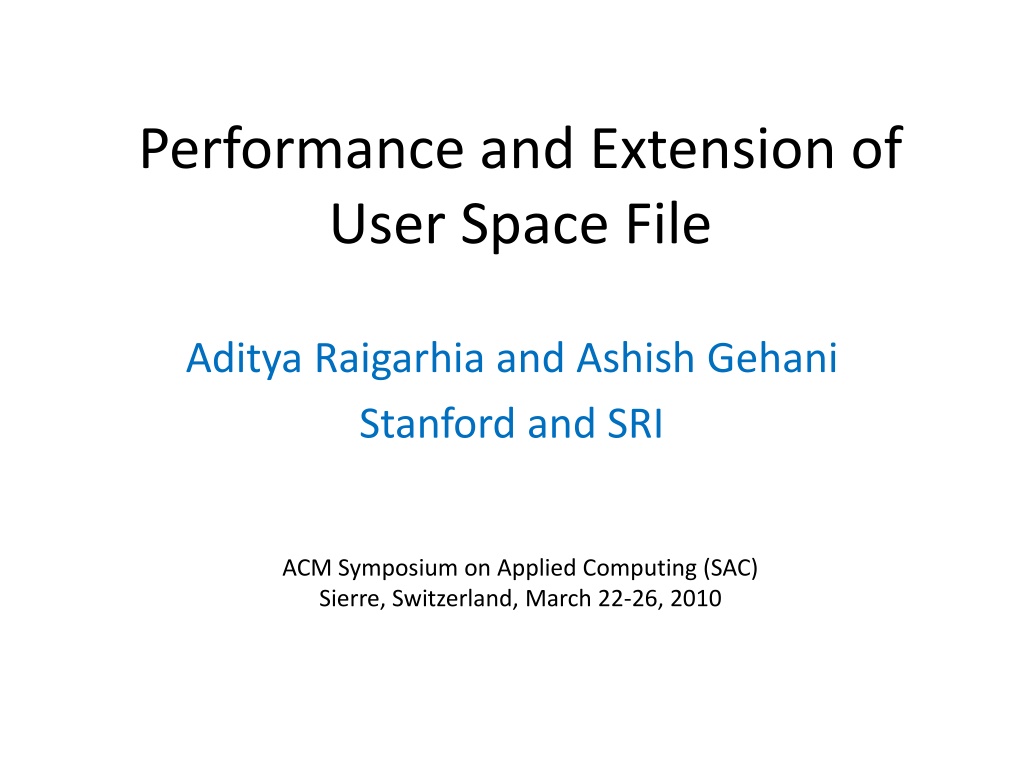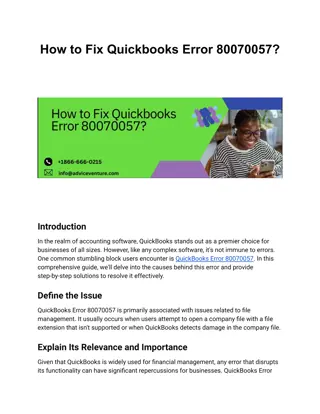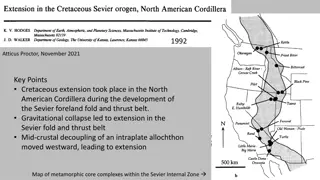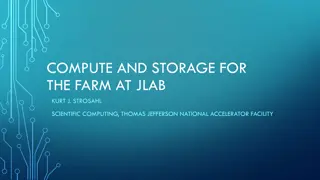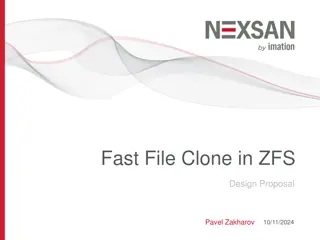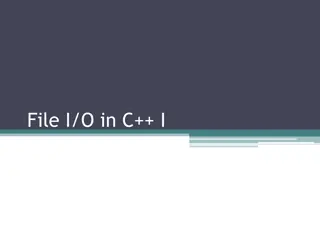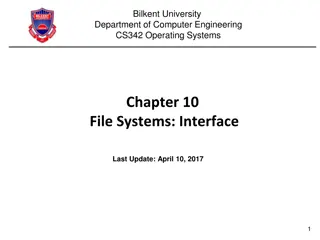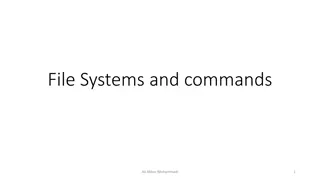User Space File Systems: Performance and Extension
Developing in-kernel file systems can be challenging due to the steep learning curve and restrictions. Modern file system research focuses on adding functionality in user space environments, offering advantages such as a wide range of languages and 3rd party tools. The FUSE framework provides a solution by enabling users to develop file systems in user space, enhancing performance. Explore the comparison between user space and kernel file systems, addressing performance issues and potential solutions.
Download Presentation

Please find below an Image/Link to download the presentation.
The content on the website is provided AS IS for your information and personal use only. It may not be sold, licensed, or shared on other websites without obtaining consent from the author.If you encounter any issues during the download, it is possible that the publisher has removed the file from their server.
You are allowed to download the files provided on this website for personal or commercial use, subject to the condition that they are used lawfully. All files are the property of their respective owners.
The content on the website is provided AS IS for your information and personal use only. It may not be sold, licensed, or shared on other websites without obtaining consent from the author.
E N D
Presentation Transcript
Performance and Extension of User Space File Aditya Raigarhia and Ashish Gehani Stanford and SRI ACM Symposium on Applied Computing (SAC) Sierre, Switzerland, March 22-26, 2010
Introduction (1 of 2) Developing in-kernel file systems challenging Understand and deal with kernel code and data structures Steep learning curve for kernel development No memory protection No use of debuggers Must be in C No standard C library In-kernel implementations not so great Porting to other flavors of Unix can be difficult Needs root to mount tough to use/test on servers
Introduction (2 of 2) Modern file system research adds functionality over basic systems, rather than designing low- level systems Ceph [37] distributed file system for performance and reliability uses client in users space Programming in user space advantages Wide range of languages Use of 3rd party tools/libraries Fewer kernel quirks (although still need to couple user code to kernel system calls)
Introduction - FUSE File system in USEr space (FUSE) framework for Unix- like OSes Allows non-root users to develop file systems in user space API for interface with kernel, using fs-type operations Many different programming language bindings FUSE file systems can be mounted by non-root users Can compile without re-compiling kernel Examples WikipediaFS [2] lets users view/edit Wikipedia articles as if local files SSHFS access via SFTP protocol
Problem Statement Prevailing view user space file systems suffer significantly lower performance compared to kernel Overhead from context switch, memory copies Perhaps changed due to processor, memory and bus speeds? Regular enhancements also contribute to performance? Either way measurement of prevailing view
Outline Introduction Background FUSE overview Programming for FS Benchmarking Results Conclusion (done) (next)
Background Operating Systems Microkernel (Mach [10], Spring [11]) have only basic services in kernel File systems (and other services) in user space But performance is an issue, not widely deployed Extensible OSes (Spin[1], Vino[4]) export OS interfaces User level code can modify run-time behavior Still in research phase
Background Stackable FS Stackable file systems [28] allow new features to be added incrementally FiST [40] allows file systems to be described using high-level language Code generation makes kernel modules no recompilation required But cannot do low-level operations (e.g., block layout on disk, metatdata for i-nodes) Still require root to load
Background NFS Loopback NFS loopback servers [24] puts server in user- space with client Provides portability Good performance But Limited to NFS weak cache consistency Uses OS network stack, which can limit performance
Background - Misc Coda [29] is distributes file system Venus cache manager in user space Arla [38] has AFS user-space daemon But not widespread ptrace() process trace Working infrastructure for user-level FS Can interacept anything But significant overhead puffs [15] similar to FUSE but NetBSD FUSE built on puffs for some systems But puffs not as widespreadh
Background FUSE contrast FUSE similar since loadable kernel module Unlike others is mainstream part of Linux since 2.6.14, ports to Mac OSX, OpenSolaris, FreeBSD and NetBSD Reduces risk of obsolete once developed Licensing flexible free and commercial Widely used (examples next)
Background FUSE in Use TierStore [6] distributed file system to simply deployment of apps in unreliable networks Uses FUSE Increasing trend for dual OS (Win/Linux) NTFS-3G [25] open source NTFS uses FUSE ZFS-FUSE [41] is port of Zeta FS to Linux VMWare disk mount [36] uses FUSE on Linux
FUSE Example SSHFS on Linux https://help.ubuntu.com/community/SSHFS % mkdir ccc % sshfs -o idmap=user claypool@ccc.wpi.edu:/home/claypool ccc % fusermount -u ccc
Outline Introduction Background FUSE overview Programming for FS Benchmarking Results Conclusion (done) (done) (next)
FUSE Overview On userfs mount, FUSE kernel module registers with VFS e.g., call to sshfs userfs provides callback functions All file system calls (e.g., read()) proceed normally from other process When targeted at FUSE dir, go through FUSE module If in page cache, return Otherwise, to userfs via /dev/fuse and libfuse userfs can do anything (e.g., request data from ext3 and add stuff) before returning data fusermount allows non- root users to mount
FUSE APIs for User FS Low-level Resembles VFS user fs handles i-nodes, pathname translations, fill buffer, etc. Useful for from scratch file systems (e.g., ZFS-FUSE) High-level Resembles system calls User fs only deals with pathnames, not i-nodes libfuse does i-node to path translation, fill buffer Useful when adding additional functionality
FUSE Hello World Example Flow Run ~/fuse/example$ mkdir /tmp/fuse ~/fuse/example$ ./hello /tmp/fuse ~/fuse/example$ ls -l /tmp/fuse total 0 -r--r--r-- 1 root root 13 Jan 1 1970 hello ~/fuse/example$ cat /tmp/fuse/hello Hello World! ~/fuse/example$ fusermount -u /tmp/fuse ~/fuse/example$ http://fuse.sourceforge.net/helloworld.html
FUSE Hello World (1 of 4) Callback operations Invoking does mount http://fuse.sourceforge.net/helloworld.html
FUSE Hello World (2 of 4) Fill in file status structure (type, permissions) http://fuse.sourceforge.net/helloworld.html
Check that path is right Check permissions right (read only) Check that path is right Copy data to buffer http://fuse.sourceforge.net/helloworld.html
FUSE Hello World (4 of 4) Copy in directory listings http://fuse.sourceforge.net/helloworld.html
Performance Overhead of FUSE : Switching When using native (e.g., ext3) Two user-kernel mode switches (to and from) Relatively fast since only privilege/unpriviledge No context switches between processes/address space When using FUSE Four user-kernel mode switches (adds up to userfs and back) Two context switches (user process and userfs) Cost depends upon cores, registers, page table, pipeline
Performance Overhead of FUSE : Reading FUSE used to have 4 KB read size If memory constrained, large reads would do many context switch each read swap out userfs, bring in page, swap in userfs, continue request, swap out userfs, bring in next page FUSE now reads in 128 KB chunks with big_writes mount option Most Unix utilities (cp, cat, tar) use 32 KB file buffers
Performance Overhead of FUSE : Time for Writing (Write 16 MB file) Note, benefit from 4KB to 32KB, but not 32KB to 128KB
Performance Overhead of FUSE : Memory Copying For native (e.g., ext3), write copies from application to kernel page cache (1x) For user fs, write copies from application to page cache, then from page cache to libfuse, then libfuse to userfs (3x) direct_io mount option bypass page cache, user copy directly to userfs (1x) But reads can never come from kernel page cache!
Performance Overhead of FUSE : Memory Cache For native (e.g., ext3), read/written data in page cache For user fs, libfuse and userfs both have data in page cache, too (extra copies) useful since make overall more efficient, but reduce size of usable cache
Outline Introduction Background FUSE overview Programming for FS Benchmarking Results Conclusion (done) (done) (done) (next)
Language Bindings 20 language bindings can build userfs in many languages C++ or C# for high-perf, OO Haskell and OCaml for higher order functions (functional languages) Erlang for fault tolerant, real-time, distributed (parallel programming) Python for rapid development (many libraries) JavaFuse [27] built by authors
Java Fuse Provides Java interface using Java Native Interface (JNI) to communicate from Java to C Developer writes file system as Java class Register with JavaFuse using command line parameter JavaFuse gets callback, sends to Java class Note, C to Java may mean more copies Could have file meta-data only option Could use JNI non-blocking I/O package to avoid But both limit portability and are not thread safe
Outline Introduction Background FUSE overview Programming for FS Benchmarking Results Conclusion (done) (done) (done) (done) (next)
Benchmarking Methodology (1 of 2) Microbenchmarks raw throughput of low-level operations (e.g., read()) Use Bonnie [3], basic OS benchmark tool 6 phases: 1. write file with putc(), one char at a time 2. write from scratch same file, with 16 KB blocks 3. read file with getc(), one char at a time 4. read file, with 16 KB blocks 5. clear cache, repeat getc(), one char at a time 6. clear cache, repeat read with 16 KB blocks
Benchmarking Methodology (2 of 2) Macrobenchmarks application performance for common apps Use Postmark small file workloads by email, news, Web-based commerce under heavy load Heavy stress of file and meta-data Generate initial pool of random text files (used 5000, from 1 KB to 64 KB) Do transactions on files (used 50k transactions, typical Web server workload [39]) Large file copy copy 1.1 GB movie using cp Single, large file as for typical desktop computer or server
Testbed Configurations Native ext4 file system FUSE null FUSE file system in C (passes each call to native file system) JavaFuse1 (metadata-only) null file system in JavaFuse, does not copy read() and write() over JNI JavaFuse2 (copy all data) copies all over JNI
Experimental Setup P4, 3.4 GHz, 512 MB RAM (increased to 2 GB for macrobenchmarks), 320 GB Seagate HD Maximum sustained throughput on disk is 115 MB/s So, any reported throughputs above 115 MB/s must benefit from cache Linux 2.6.30.5, FUSE 2.8.0-pre1
Outline Introduction Background FUSE overview Programming for FS Benchmarking Results Conclusion (done) (done) (done) (done) (done) (next)
Microbenchmark Results FUSE ~25% overhead Context switches JavaFuse more overhead (context switches between JNI and C), and doing copies not much worse than metadata
Microbenchmark Results Native much faster than FUSE for small files (written to memory) For large cache, written to disk which dominates
Microbenchmark Results Data already in page cache, so fast for all Spikes are when 512 MB RAM exhausted (FUSE has two copies, so earlier around 225)
Microbenchmark Results For native, can cached up to 500 MB For Java, spike is caused by artificial nature of benchmark (previous version still in cache)
Microbenchmark Results input When cache cleared, starts lower gets higher for larger Kernel optimizes for sequential read FUSE does better think it s because fusefs and ext4 both read-ahead
Microbenchmark Results Native gets same benefit as FUSE, so no apparent difference
Postmark Macrobenchmark Results FUSE overhead less than 10% Java overhead about 60% Greater CPU and memory use
Copy 1.1 GB File Macrobenchmark Results FUSE comparable to native (~30%) Java overhead minimal over FUSE
Conclusion FUSE may be feasible depending upon workload Performance comparable to in-kernel for large, sustained I/O Overhead noticeable for large number of meta data (e.g., Web and many clients) Adequate for PCs and small servers for I/O transfer Additional language (Java) incurred additional overhead But overhead can be reduced with optimizations (e.g., shared buffers)
